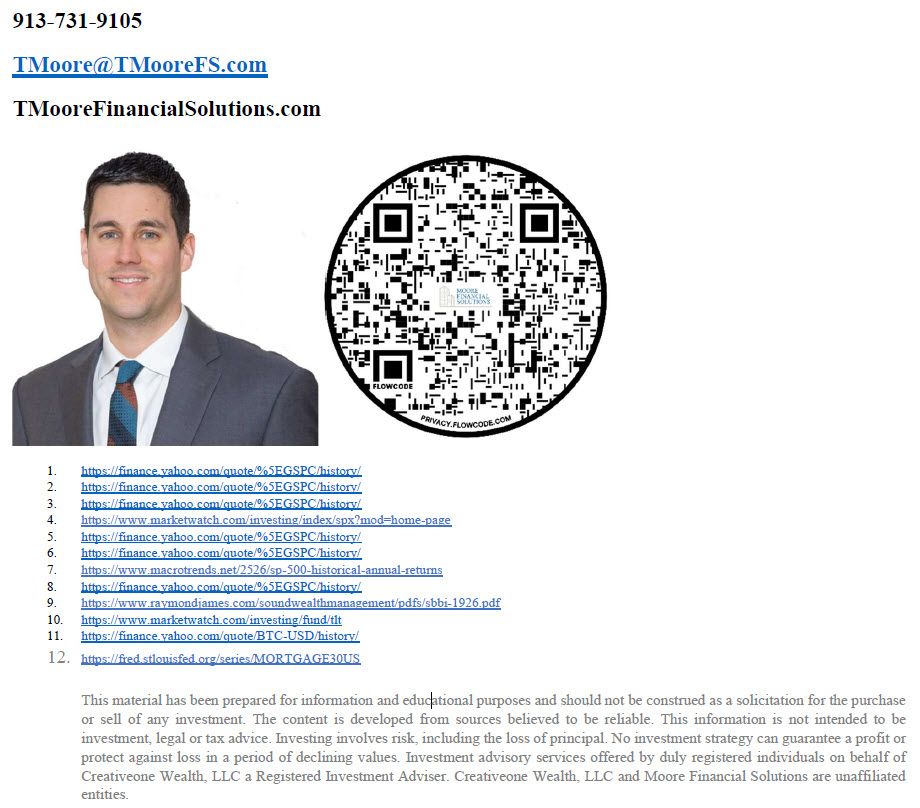Q4 of 2022 offered an increase in the S&P 500 of 7.08%, as investors’ portfolios regained a
portion of the losses brought on by a down year (1). During this most recent quarter, the S&P 500 pushed higher, before seeing a retreat to the closing price of 3,839.50 (2). We remain optimistic that market sentiment shows the continued opportunity and belief that this market downturn will end, and investors will be back to making money in stocks. In the opinion of Moore Financial Solutions, the sharp movement upward from the quarter’s opening price of 3,585.62 to 4,080.11 (13.79% increase) in the first two months of Q4 show investors’ belief that we will get past this downturn, and eventually return to all time market highs (3). As a point of reference, the S&P 500 briefly touched 4,797.70 in January, which represents the highest level of the year (4). This high point in the market is 24.96% above the closing price of 2022 (5). The year ended with a -19.44% return for the S&P 500, before factoring in dividends (6). This resulted in the second down year in the last decade, after factoring in dividends (7). One decade ago, the S&P 500 opened the year for 2013 at 1,462.42 and has moved up 163% (plus paid an approximate 1.5% dividend each year) (8). We reference this decade of movement as a reminder that if you are willing to tolerate the ups and downs of the market, it has historically generated returns.
The Moore F.S. management philosophy remains the same; own a variety of diversified stocks touching on a variety of market capitalizations. For clients closer to their goals, or withdrawing from their portfolio, bonds become appropriate to ease the volatility of the portfolio. Focusing mainly on clients with long time horizons (funds invested for 10+ years), we do not believe bonds should be used. Many other firms that you see advertised include bonds in their portfolios, regardless of a long time horizon. We believe this is because they have a weaker relationship with their clients and feel the need to reduce volatility in a portfolio. By contrast, we aim to have a very strong relationship with our clients and educate them that stocks will move in both directions, and that they should plan to buy and hold for the long term. By eliminating bonds in these portfolios, we aim to buy and hold quality stocks which historically generate approximately double the return of bonds (9). Furthermore, in 2022 bonds did not offer the cushion that these large firms had hoped for. We believe this can be seen by examining the move of the iShares 20+ year treasury bond ETF (TLT), which moved from $148.19 per share to $99.56 per share in 2022, a reduction of 32.82% (10). Instead of using bonds that offer little upside potential, we aim to continue to use dividend paying stocks and value stocks, as opposed to purely growth stocks. In July, we moved $207,165.53 out of bonds as the Federal Reserve seemed determined to increase interest rates. Shortly after this move interest rates increased, and bonds decreased in price. These funds were later moved back into bonds to take advantage of the interest rate decrease on the horizon. As a reminder, bonds lose value as interest rates rise and gain value as interest rates decrease. At Moore F.S. we take pride in our money management style and continue to manage every account on an individual and personalized basis. We remain committed to always acting in your best interest while managing your money as an un-biased fiduciary.
A major headline of Q4 included Sam Bankman-Fried and his titanic fall from an estimated worth of $26.5 billion, to being one of the most wanted white collar criminals in history. You likely have some knowledge of SBF, but we would like to highlight this event and lightly touch on bitcoin as it relates to your portfolio, or rather we should say how it does not relate to your portfolio. SBF is known not just for his funny hairdo, but for being the founder of FTX. You may have first noticed FTX by watching Major League Baseball, as the umpires wore it on their uniforms as a method of advertising. The MLB didn’t forecast that they were advertising a firm that was diverting client money into a completely different hedge fund to help pay its debts and create investments to the tune of $10 billion. Furthermore, bitcoin’s price moved down 15.02% in Q4 and is down 74.33% from November 2021 highs (11). We reference the SBF story as it is major news within Q4, and we reference bitcoin prices as a reminder that there is no need to reinvent the wheel in finding alternatives to stock investments, in our opinion. In 2021 the Moore F.S. phone would ring a couple times a week with questions regarding investing in bitcoin, and how this could be done on our platform. We are proud to say that we have never put a penny of investor money into cryptocurrencies and have no intention to. You’re likely not surprised that we haven’t received many questions regarding cryptos recently. Lastly, we think it is worth stating that all Moore F.S. investor funds are held at TD Ameritrade, which we feel is the best in the business regarding custodian of assets.
A new year brings new challenges and new goals. We think 2023 will be a fruitful year for stocks if a few things can happen. Inflation data needs to show that Federal Reserve interest rate increases are having the desired effect in cooling the economy. As a reminder, an overheating economy creates a lack of price stability. We remain optimistic that the Federal Reserve will not overtighten financial conditions too quickly or too much. Earnings for corporations will need to avoid a dramatic decrease. Clearly, earnings may fall as a result of interest rate increases, as buyers electing to finance large purchases (homes, cars, etc.) can buy less units for the same monthly payment. For example, 30-year mortgage rates moved up approximately 3% from ~3.5% to ~6.5% throughout 2022 (12). This means a $250,000 home’s monthly payment moved up $457.56 from $1,122.61 to $1,580.17. This change erodes the buyer’s discretionary income for other items and will likely have an impact on their spending. To this point Moore F.S. aims to increase portfolio holdings of financials as their overall margins should improve. We have been cautious of increasing our weighting into financials because an inverted yield curve tends to not be favorable to the banking industry. An inverted yield curve means short term rates are higher than long term rates despite a long term loan being more impacted by many years of inflation. We encourage you not to overpay loans that have an interest rate of less than 5% as these funds could be better directed somewhere else, in our opinion. If you are actively overpaying loans of less than 5%, please reach out to us to discuss potentially more favorable alternatives. Keep in mind, if your mortgage payment is $1,000 per month, for example, after many years of inflation, that $1,000 per month may feel more like $750 per month one day. Additionally, by overpaying your loan you lose that liquidity, and if a financial emergency occurs you do not have that overpayment to draw back out, where you could access an investment account in an emergency. In our opinion, this is one of the few times where you can get a better rate and take a more conservative approach, conservative in terms of keeping your liquidity. It is worth stating that the avoidance of interest by overpaying is a sure thing in most cases, where the returns an investment could offer are generally not guaranteed, so this is worth taking into consideration.
I want to personally take this time to wish you and your family all the best in 2023. Every account I manage represents someone’s goals and freedom to make their life better. 2022 was equally as tough on me as it was for you as the investor. Although I try hard to educate you that these years will happen, it doesn’t make them much easier to endure. There are things you can do to take advantage of the recent downturn in the markets. If you still have a medium or long time horizon you can get money into the stock market while it offers a better entry price than it did for most of last year. If you are withdrawing it may be a great opportunity to challenge yourself to decrease the withdraw amount. The stock market is like electricity within your home, when used correctly, it enhances our everyday lives. But, if used improperly, it can harm us. In my opinion, for investors with the willingness to tolerate the volatility of stocks, there is no better way to create passive income and wealth. It is with great pride that I continue to be your fiduciary and I welcome all your questions and concerns, even if it does not directly relate to the accounts I manage. My main goal is to make your life better by being in it, and I thank you for your continued trust and letting me manage your goals as your independent fiduciary.






